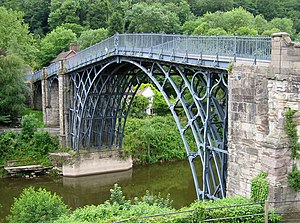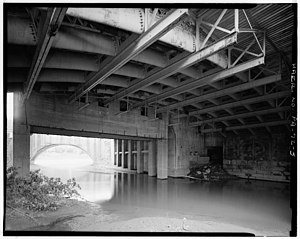 |
| http://explorepahistory.com/displayimage.php?imgId=1-2-E4E |
Hello everyone,
I decided to follow up and show an expanded detail of the Dunlap's Creek Bridge located in Brownsville, Pennsylvania. This great structure has largely been forgotten by the citizens of the United States.
This series of posts has to do with a big announcement I will be making on here in the up coming weeks about a find related to the bridge, that may shed some light on the early history of its construction.
I decided to follow up and show an expanded detail of the Dunlap's Creek Bridge located in Brownsville, Pennsylvania. This great structure has largely been forgotten by the citizens of the United States.
This series of posts has to do with a big announcement I will be making on here in the up coming weeks about a find related to the bridge, that may shed some light on the early history of its construction.
The Dunlap's Creek Bridge is not a celebrated structure in the US as the Coalbrookdale Bridge is in England. For those of you who may not know, the Coalbrookdale Bridge is the first cast iron bridge ever constructed. Located in England, the bridge crosses the River Severn in Shropshire.
 |
| Henshaw 2011 |
Our first cast iron bridge is more of an enigma. Nestled on a narrow point on Historic Route 40, the bride is easy to miss. There is no fanfare, signs, or anything that jumps out at the motorist driving over what appears to be a hump in the road. The town of Brownsville, once a thriving industrial center, is now largely empty. It's leadership has failed to grasp the commercial value of the bridge or the symbol that it stands for in American history. What should be the centerpiece of the town is instead a curiosity which no-one seems to know what to do with. There was a mural placed on a building showing the bridge when it was newly constructed. It's nice, but why not just show people the bridge? I invite all of my readers to make a pilgrimage to Brownsville, Pennsylvania this May, 2012 where I promise to give you a personal tour of this great structure.
In the mean time, here are some great drawings from the Historic American Engineering Record (HAER for short). These illustrate the construction methods used in building the bridge. Here is the website for further reading: http://www.loc.gov/pictures/item/PA1412/
 |
| HAER Library of Congress |
"The bridge was constructed of 250 castings and spanned 80 feet. There were 5 elliptical tube cast iron arches spaced 5 feet 10 inches apart. Each arch tube was made up of 9 voussoirs that were connected by a flanged collar held together by bolts. Each arch was attached to an iron spring plate that rested on a stone abutment. The sandstone abutments were 42 feet high and 25 feet wide. The arches were held in place by St. Andrew’s crosses for bracing purposes."
 |
| HAER Library of Congress |
From the illustration, it is easy to see the elliptical castings of the voussoirs and their flanges. Voussoir is basically a wedged shaped piece of an arch in stone masonry. Each of these voussoirs in the Dunlap's Creek Bridge are held together by a flange. In a stone arch, the voussoirs would be held together by a keystone at its center. Captain Delafield understood that the ability to cast iron into an elliptical tube and connect the pieces together would negate the need for a "keystone" as the weight of the arch is spread out over the tops of the arch by the St. Andrews Crosses.
Currently, the bridge is mostly obscured by vegetation overgrowth and the remains of two buildings that flanked it on either side. Access to the structure is limited due to the steep slopes of Dunlap's Creek channel. Perhaps one day Brownsville will capitalize on this unique structure, and look to Coalbrookdale as a model.
| Dunlap's Creek Bridge, Spanning Dunlap's Creek, Brownsville, Fayette County, PA (Photo credit: Wikipedia) |



